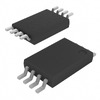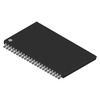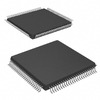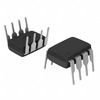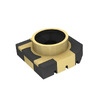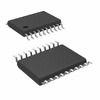Guide to the LM339AN Quad Voltage Comparator
In the dynamic world of electronics, a deep understanding of components and their applications is basic for effective design and innovation. This article focuses on demystifying comparators by examining their functionality, design, and practical uses. With a focus on examples and serious considerations, we will explore how these components bridge the gap between notional constructs and practical implementations, shedding light on their focal role in modern electronics. As we dive into the details of the LM339AN, we will uncover its features, design considerations, and the impact it has on enhancing system reliability and performance in various fields.Catalog

Core Principles of Comparators
A comparator represents an active electronic circuit crafted to measure and contrast an incoming analog signal with a predetermined reference voltage. This circuit architecture includes two analog inputs and a single binary output. The comparator's binary output remains stable despite fluctuations in input voltage, functioning akin to a 1-bit analog-to-digital converter. It excels at pinpointing when an input signal meets or exceeds a defined threshold, making it requisite in a range of electronic applications, such as triggering logic circuits.
Comparators can be constructed using an assortment of components. Options include diodes, transistors, and operational amplifiers (op-amps). Certain comparator chips, such as the LM324, LM358, uA741, TL081/2/3/4, OP07, and OP27, are commonly employed. Notably, specialized comparators like the LM339 and LM393 are distinguished for their rapid switching capabilities and minimal delay, catering to applications that demand swift performance. In practical implementations, comparators are integrated into circuits where threshold detection plays a basic role. In power supply units, comparators vigilantly monitor voltage levels to ensure they stay within safe boundaries. Within analog-to-digital converters (ADCs), comparators adeptly facilitate precise digital approximation of analog signals.
Reflecting on hands-on experiences, one can discern that the choice of comparator profoundly impacts a circuit's efficiency and reliability. Attention to factors such as response time, offset voltage, and power consumption is used to the development of high-speed data acquisition systems, employing low-delay comparators like the LM393 can suggestively bolster data integrity. Incorporating hysteresis into the comparator design often proves advantageous. Hysteresis introduces a buffer that mitigates erratic output, mostly in settings with noisy input signals. This strategy enhances output stability, ensuring consistent performance.
Detailed Examination of the LM339AN Comparator
The LM339AN stands out as a versatile voltage comparator chip, featuring four independent comparators within a single package. This inherent flexibility allows it to seamlessly interface with high-voltage digital logic circuits and both TTL and CMOS systems. Its remarkable adaptability shines through, operating across a wide voltage range and supporting either single or split power supplies, thus becoming valuable in diverse applications.
An outstanding feature of the LM339AN is its extensive operating temperature range of 0°C to 70°C. Such a characteristic enhances its suitability for various environments and applications. For instance, in consumer electronics, it plays a major role. Moreover, it finds its place in automotive systems, ensuring stability and performance. Industrial control mechanisms also benefit, where maintaining temperature stability is dangerous. This device’s ability to operate effectively across different temperatures adds to its reliability, making it a trusted component in multiple sectors.
Another notable advantage of the LM339AN is its seamless compatibility with TTL and CMOS systems. This facilitates its integration into existing digital systems without necessitating substantial modifications. In practical applications, the LM339AN proves invaluable in areas like signal processing, where precise voltage comparisons are dynamic for maintaining system integrity. It also demonstrates its robustness in safety-dangerous applications, such as power supply monitoring and overvoltage protection, emphasizing its reliability and widespread adoption.
Equivalent Replacements
- LM239AN
Pin Configuration, Symbol, and Footprint of the LM339AN Comparator
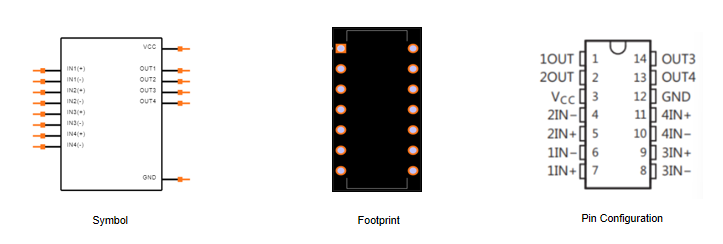
The LM339AN holds a substantial place in various electronic circuits, celebrated for its quad comparator op-amp setup and its complex functionality. Each of its 14 pins contributes uniquely to the device's overall performance, ensuring its effective operation in applications.
Pin Configuration
• Pin 1 (Output 1): This pin serves as the output for the first comparator op-amp, a major element for obtaining the comparison result from its corresponding inputs, marking the beginning of the device's intricate symphony.
• Pin 2 (Output 2): Functioning as the output for the second comparator op-amp, it provides a pathway for the refined signal processed from its respective inputs.
• Pin 3 (Vcc): The lifeline of the device, the positive power supply pin energizes the entire device, usually connected to a higher voltage potential within the circuit, breathing life into the component's heart.
• Pin 4 (Inverting Input 2): Accepting the inverting input for the second comparator op-amp, it plays a major role in differential signal analysis, a subtle yet basic function.
• Pin 5 (Non-Inverting Input 2): This pin receives the non-inverting input for the second comparator op-amp, working synergistically with Pin 4 to ensure precise comparisons.
• Pin 6 (Inverting Input 1): Assigned to the inverting input of the first comparator op-amp, it’s instrumental in the overall operation, adding to the delicate balance required.
• Pin 7 (Non-Inverting Input 1): Dedicated to the non-inverting input of the first comparator op-amp, enhancing the differential input analysis suitable for the device's functionality.
• Pin 8 (Inverting Input 3): Working as the inverting input for the third comparator op-amp, it’s a dangerous component in numerous applications, silently upholding its responsibilities.
• Pin 9 (Non-Inverting Input 3): Serving as the non-inverting input for the third comparator op-amp, it works in tandem with Pin 8, a partnership that ensures operational excellence.
• Pin 10 (Inverting Input 4): Functioning as the inverting input for the fourth comparator op-amp, it plays a basic role, adding depth to the device's operational capabilities.
• Pin 11 (Non-Inverting Input 4): This pin inputs the non-inverting signal for the fourth comparator op-amp, ensuring proper interaction with Pin 10, a silent yet dynamic connection.
• Pin 12 (Gnd): The ground pin acts as the stabilizing anchor for the device, offering a reference point for all other voltages in the circuit, grounding the device in reality.
• Pin 13 (Output 4): Corresponding to the output of the fourth comparator op-amp, it carries the result of the final comparison, culminating the device’s functional cycle.
• Pin 14 (Output 3): Outputs the result from the third comparator op-amp, thus completing the intricate quad configuration, each pin contributing to the device's harmonious performance.
LM339AN Comparator Features
Wide Differential Input Voltage Range
The LM339AN boasts a differential input voltage range that aligns harmoniously with the supply voltage, offering substantial versatility for various applications. This feature accommodates different voltage levels, facilitating smooth integration into an array of systems. Additionally, the device adeptly handles a broad internal resistance range within the comparison signal source, thereby enhancing operational adaptability. Such adaptability proves fruitful in practical scenarios where system designers often face fluctuating or varying input resistances.
Modest Offset Voltage
The LM339AN exhibits a modest 2mV offset voltage, a characteristic that plays a basic role in ensuring precise voltage comparisons. This low offset voltage suggestively improves both the accuracy and linearity of the comparator. In practical terms, this translates to higher fidelity in monitoring and regulating voltage levels, thereby boosting the overall stability and efficiency of the system.
Versatile Power Supply Options
The LM339AN is remarkably adaptable, supporting a comprehensive range of power supply options. It can operate with a single power supply voltage ranging from 2V to 36V, and a dual power supply voltage ranging from ±1V to ±18V. This versatility makes the LM339AN suitable for a myriad of power environments, providing designers with the flexibility to incorporate it into systems with diverse power supply configurations. This characteristic is highly valuable for broad applications, including the automotive and industrial sectors, where power supply conditions can vary considerably.
Adjustable Output Potential
The adjustable output potential setting function of the LM339AN facilitates the easy selection of output thresholds, catering to the demands of diverse applications. This flexibility greatly simplifies the design process and reduces configurational complexities. In actual scenarios, the ability to fine-tune output potentials can knowingly enhance system performance, mostly in applications requiring precise control of output signals such as sensor interfaces and control systems.
Technical Specifications of the LM339AN Comparator
|
Product Attribute |
Attribute Value |
|
Manufacturer |
Texas
Instruments |
|
Package
/ Case |
PDIP-14 |
|
Packaging |
Tube |
|
Length |
19.3
mm |
|
Width |
6.35
mm |
|
Height |
4.57
mm |
|
Power
Dissipation |
1.05
W |
|
Technology |
Bipolar |
|
Response
Time |
1.3
µs |
|
Part
Status |
Active |
|
Supply
Voltage |
2 V
~ 30 V |
|
Operating
Temperature |
0°C
~ 70°C |
|
Pin
Count |
14 |
|
Input
Bias Current |
250
nA |
|
Mounting
Style |
Through
Hole |
|
Number
of Channels |
4
Channel |
|
Product
Type |
Analog
Comparators |
Common Applications of LM339AN Comparator
The LM339AN finds use in an array of applications, each exhibiting its versatility and import impact on modern technology.
Proportional Amplifiers
Proportional amplifiers are enhanced by the LM339AN, which boosts weak signals to desired levels. The amplification factor can be finely tuned using feedback resistors, allowing for precise signal integrity. In practical use, precision instrumentation leverages this to ensure accurate measurements and sensitive detections, emphasizing its significance.
Electronic Scales
In electronic scales, the LM339AN translates weight into voltage signals. These signals are compared with a reference voltage to determine the precise weight. This method guarantees high precision and reliability. Commercially, such scales are widely used in retail and industrial settings.
Voltage Monitoring
Voltage monitoring systems leverage the LM339AN to track battery or power supply voltages. Upon reaching predefined thresholds, the comparator triggers appropriate actions, safeguarding electronic systems from voltage anomalies. This practice is especially relevant in maintaining equipment longevity and performance.
Motor Control
The LM339AN plays a major role in motor control, identifying motor position and speed. This is useful for the precise control of stepper motor systems, common in robotics and automated machinery, enhancing accuracy and efficiency in advanced manufacturing processes.
Analog Switches
Configured as a switch, the LM339AN manages other circuit elements in complex circuits requiring selective connectivity. Practical uses include communication systems where signal routing is desired for seamless data flow.
Waveform Generators
Waveform generators benefit from the LM339AN for creating square and pulse waveforms of various frequencies and duty cycles. This function is useful in signal processing, testing, and measurement, broadening the comparator's utility across diverse technological fields.
Temperature Control
The LM339AN is active in temperature control systems, converting temperature variations into voltage signals compared to a reference voltage to deliver precise readings. This application is key in environments needing stringent temperature regulation, such as laboratory experiments and industrial processes, ensuring ideal conditions for hazardous operations.
LM339AN Comparator Packages and Dimensions
The LM339AN comparator is housed in a Plastic Dual Inline Package (PDIP). Its precise dimensions are 19.3mm x 6.35mm x 4.57mm. This compact form factor not only supports surface mount technology (SMT), but it also ensures compatibility with high-density assembly processes. These attributes are invaluable for modern electronics manufacturing.
Packaging in Comparator Implementation
The packaging of electronic components like the LM339AN extends beyond physical constraints; it is focal for the device's performance. SMT compatibility, facilitated by the PDIP format, supports streamlined automated assembly lines. This reduces manual intervention and enhances reliability. Moreover, the thermal performance of the PDIP package aids in dissipating heat. Effective heat dissipation can influence the longevity and stability of the comparator across various applications.
High-Density Assemblies
Moving towards high-density assembly in practice demands components that maximize board real estate efficiency while maintaining robust performance. The LM339AN’s dimensions make it a fitting choice for complex, multi-layered circuit boards where space-saving is dynamic. Using such compact and reliable packages, engineers can achieve higher integration levels without compromising mechanical or electrical integrity.
SMT Efficiency in Industrial Production
Manufacturing processes hugely benefit from components like the LM339AN, mainly those designed for SMT. Automated placement machines operate with high precision and speed to place components on printed circuit boards (PCBs). The standardized PDIP package improves the throughput of these machines through resilience and ease of handling. This streamlined production flow lowers production costs and reduces error rates. Consequently, faster time-to-market for electronic products becomes a tangible benefit in today's fiercely competitive market.
The Art of Voltage Comparison with LM339AN
Connect Input Voltages
Start by attaching the voltages to the two input terminals of the comparator. Specifically, connect to the non-inverting (+) and inverting (-) inputs. This basic setup allows the comparator to evaluate the relative magnitudes of the inputs.
Establish a Reference Voltage
Create a reference voltage for comparison. Typically, connect the reference voltage to the comparator's reference input, often through a resistor. This resistor creates an adder circuit that aids in fine-tuning the reference voltage. Ensuring stability in fluctuating environments is used for accurate comparisons.
Configure the Output
Link the comparator's output to the intended circuit. Utilize an external pull-up resistor to adjust the output threshold voltage to a desired level. This ensures reliable and precise signal interpretation in subsequent circuit stages, minimizing interpretation errors.
Ensure Power Supply and Grounding
Adequately power the comparator and establish a solid ground connection. A stable power supply reduces the risk of noise and voltage fluctuations, which could compromise the accuracy of the voltage comparison.
Fine-Tuning and Monitoring
Continuously monitor the comparator's output. Fine-tune the input voltages as desired. Adjust the threshold voltage to achieve the desired comparison results. Precision is especially wanted in sensitive applications, where minor adjustments can pointedly impact overall performance.
With these steps carefully followed, you can master the art of voltage comparison using the LM339AN, achieving accurate and reliable results tailored to specific applications.
Frequently Asked Questions [FAQ]
1. What is the voltage comparator in LM339?
The LM339 features four independent voltage comparators within a 14-pin IC. It operates from either a single or dual power supply, with voltage differences ranging from 2V to 36V. This adaptability makes it suitable for various electronic applications, especially where precise voltage monitoring is a must.
2. What is the LM339AN?
The LM339AN is a versatile quad-voltage comparator IC that includes four independent comparators in a single package. Mainly used in voltage comparison and decision-making applications. Known for its reliable performance. Utilized across a wide range of circuits
3. What is the response time of LM339AN?
The LM339AN has a response time of 1.3 microseconds, making it suitable for high-speed applications. Enhances utility in systems requiring timely decision-making. Ideal for fast-switching electronics and real-time signal processing
4. What is the purpose of a voltage comparator?
A voltage comparator is designed to evaluate two input voltages and output a digital signal indicating the higher voltage. Output goes high if the non-inverting input is greater than the inverting input, and output goes low otherwise. Used in threshold detectors, and zero-crossing detectors. Useful in various decision-making electronic devices
5. Is the LM339AN suitable for low-power applications?
The LM339AN might not be the best fit for low-power applications due to its power consumption, even in idle states. Better alternatives exist for battery-operated devices. Basic for designing energy-efficient systems to consider other options
About us
ALLELCO LIMITED
Read more
Quick inquiry
Please send an inquiry, we will respond immediately.
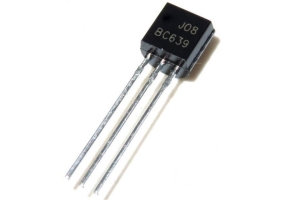
BC639 Transistor: Features, Pin Configuration, and Applications
on September 27th

S9015 PNP Transistor: Equivalent Models, Structural Insights, and C9015 Comparison
on September 27th
Popular Posts
-

What is GND in the circuit?
on January 1th 3140
-

RJ-45 Connector Guide: RJ-45 Connector Color Codes, Wiring Schemes, R-J45 Applications, RJ-45 Datasheets
on January 1th 2681
-

Understanding Power Supply Voltages in Electronics VCC, VDD, VEE, VSS, and GND
on November 15th 2246
-

Fiber Connector Types: SC Vs LC And LC Vs MTP
on January 1th 2191
-

Comparison Between DB9 and RS232
on January 1th 1806
-

What Is An LR44 Battery?
Electricity, that ubiquitous force, quietly permeates every aspect of our daily lives, from trivial gadgets to life-threatening medical equipment, it plays a silent role. However, truly grasping this energy, especially how to store and efficiently output it, is no easy task. It is against this background that this article will focus on a type of coin cell battery that may seem insignificant on the...on January 1th 1781
-

Understanding the Fundamentals:Inductance Resistance, andCapacitance
In the intricate dance of electrical engineering, a trio of fundamental elements takes center stage: inductance, resistance, and capacitance. Each bears unique traits that dictate the dynamic rhythms of electronic circuits. Here, we embark on a journey to decipher the complexities of these components, to uncover their distinct roles and practical uses within the vast electrical orchestra. Inductan...on January 1th 1733
-

What Is RF and Why Do We Use It?
Radio Frequency (RF) technology is a key part of modern wireless communication, enabling data transmission over long distances without physical connections. This article delves into the basics of RF, explaining how electromagnetic radiation (EMR) makes RF communication possible. We will explore the principles of EMR, the creation and control of RF signals, and their wide-ranging uses. The article ...on January 1th 1686
-

CR2430 Battery Comprehensive Guide: Specifications, Applications and Comparison to CR2032 Batteries
What is CR2430 battery ?Benefits of CR2430 BatteriesNormCR2430 Battery ApplicationsCR2430 EquivalentCR2430 VS CR2032Battery CR2430 SizeWhat to look for when buying the CR2430 and equivalentsData Sheet PDFFrequently Asked Questions Batteries are the heart of small electronic devices. Among the many types available, coin cells play a crucial role, commonly found in calculators, remote controls, and ...on January 1th 1685
-

Comprehensive guide to hFE in transistors
Transistors are crucial components in modern electronic devices, enabling signal amplification and control. This article delves into the knowledge surrounding hFE, including how to select a transistor's hFE value, how to find hFE, and the gain of different types of transistors. Through our exploration of hFE, we gain a deeper understanding of how transistors work and their role in electronic circu...on November 15th 1643







